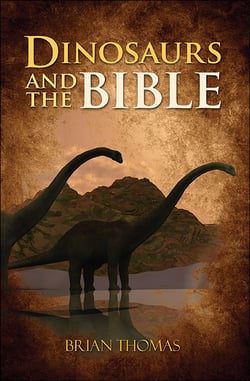
Dinosaurs—they never get old. As the success of the new movie Jurassic World shows us, our fascination with these extinct creatures is alive and well. But we still have so many questions! For example: Does the Bible mention anything about dinosaurs? Here’s an excerpt from Dinosaurs and the Bible by Brian Thomas to give us a glimpse of a possible sea serpent from ancient times…and to help unravel the mystery of Jonah and the "whale."
* * *
Some type of Mediterranean Sea creature swallowed God’s rebellious prophet Jonah when he tried to flee God’s command to go to Nineveh. The sea creature carried Jonah for three days and nights before expelling him onto dry land to carry out his mission. This creature is often described as a whale, but history identifies it as another creature entirely.
Jonah’s book uses a Hebrew word for the marine creature that is so general it could have included fish, whales, or marine reptiles—although whatever the creature was, Jonah identifies it as “great” in size. Matthew’s Gospel employs a more specific Greek word. Jesus said in Matthew 12:39-40:
An evil and adulterous generation seeks after a sign, and no sign will be given to it except the sign of the prophet Jonah. For as Jonah was three days and three nights in the belly of the great fish [“whale” in the King James], so will the Son of Man be three days and three nights in the heart of the earth.
This was originally written in Greek, and the word that the King James Version translates as “whale” was ketos. The problem is that Greek has other specific words that refer to whales, and ketos is not one of them.
Historian Bill Cooper recently helped answer this question in his remarkably relevant digital book The Authenticity of the Book of Jonah. Although knowing the animal’s exact identity is not necessary to understand the plain meaning of the Matthew text, Cooper identified an array of sources from outside the Bible that accurately describe the ketos.
Ancients used ketos to refer to a marine reptile, now likely extinct. An ancient Greek version of the Old Testament likewise translated “great fish” from Jonah 1:17 with the phrase ketei megalo, meaning a huge ketos. In particular, it was a sea serpent with a dog-like head, apparently large enough to swallow a man whole.
Early Christians in Rome and Europe painted, carved, and modeled ketos with consistent anatomy. For example, Cooper’s book includes an image of a Roman painting of Jonah being thrown from a boat to a sea monster with a dog-like head. Various artifacts show a similar animal, such as third-century marble carvings from Turkey displayed in the Cleveland Museum of Art.
The famous 230-foot-long Bayeux Tapestry housed in Normandy, France, depicts William, Duke of Normandy, conquering England in 1066. One section depicts a dog-like head adorning a ship’s prow. And like their tradition of the thunderbird, Native Americans carry strong traditions—even totem pole carvings—of a serpentine “sea wolf.” The church at Fowlis Wester in Scotland houses a Celtic cross carved around AD 800. At the top, it depicts what could be Jonah being swallowed by a ketos. A sign at the church states that the sea creature “with a wolf’s head” swallows a man.
Together, these written, carved, and stitched eyewitness testimonies show that the Lord’s earlier audience would have known exactly the kind of creature to which He referred—ketos, the dog-headed sea serpent.
* * *
It's fascinating to imagine Jonah's "whale" fitting in among the terrifying creatures that populate Jurassic World! (Enjoying a shark snack, perhaps?) Meet some other potential dinosaurs from Bible times in Dinosaurs and the Bible.
Got more dino questions? Find answers in Dinosaurs and the Bible!



